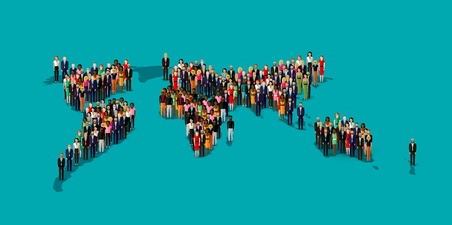The traditional measure of generations is "familial generations," where a generation is defined by a single step in the line of descent from an ancestor.
The idea of "social generations" was introduced in the 19th century. Social generations are cohorts of people who were born in the same date range, share similar cultural experiences, and have been shaped by significant events or societal trends while coming of age. Prior to this concept, “generation” had generally referred to family relationships.
William Strauss and Neil Howe, influential authors on American generations, define a social generation as the aggregate of all people born over a span of roughly twenty years or about the length of one phase of life: childhood, young adulthood, midlife, and old age.
Strauss and Howe state that generations are identified by age cohorts sharing three criteria:
- Age Location in History: Members of a generation encounter key historical events and social trends while occupying the same phase of life.
- Beliefs and Behaviors: Members of a generation are shaped in lasting ways by the eras they encounter as children and young adults and they share common beliefs and behaviors.
- Perceived Membership: Members of a generation are aware of the experiences and traits that they share with their peers, and they share a common perceived membership in that generation.
How are the Generation Names Created?
In 1945 following World War II, economists, businesses, and policy makers began labeling generations as a new way to measure and study demographics. The Baby Boomers—those born between 1946-1964—were the first generation to adopt a widely accepted label.
The generations before the Baby Boomers were named retroactively. Baby Boomers achieved their generational label due to the spike in birth rates following the war and a clear end date with the introduction of birth control.
The Census Bureau first referred to the years between 1946 and 1964 as the “Post War Baby Boom.” As the people born in this boom started to age, ad agencies began using the term “Baby Boomers” to help them target the demographic. This was the first and last time a generation’s “official” name had it’s origin in a government agency.
For Generation X, Douglas Coupland wrote a book in 1991 titled, Generation X: Talents for an Accelerated Culture, that was about the anonymity he and his contemporaries felt growing up in the shadow of Baby Boomers. The letter “X” was meant to signify this generation’s desire not to be defined.
Millennials simply refers to the generation who came of age during the 2000 millennium. In 1993, Advertising Age was credited with creating the term "Generation Y." Strauss and Howe used the term “Millennials" because the members of the generation did not want to be associated with their predecessors, Generation X. Soon after, Advertising Age conceded that Millennials was a better name and insisted that "Generation Y” was only a placeholder until more was discovered about them.
Similarly, the name of the post-Millennial generation, Generation Z, will likely change as more is discovered about the youngest generation.
Government, the advertising industry, and individuals have all had a hand in naming the generations. The naming of generations is arbitrary and typically takes time to evolve before becoming “official."
Who Sets the Dates of Generations?
There are no “official” start and end dates for the generations, except for the Baby Boomer generation. The Census Bureau claims to only define the Baby Boomer generation (1946-1964) as they were first to draw attention to the birthrates that increased from around three million a year to over four million a year following World War II.
Because there is only a general consensus on when the various generations begin and end, the date ranges differ depending on the group or study. Some define the date range of generations by where there is a shift in the social mood of an age cohort. Historians will define the date range of generations based on historical events. Demographers will define the date range of generations based on the shifts in birth rates. Others believe that to some extent the media shapes the boundaries of generations.
Defining the date ranges of generations is not an exact science, nor should it be. The dates that define the generations are useful tools for analysis, but they should be thought of as guidelines, rather than official distinctions.
Do Generations Differ Across the World?
As generations come of age, there are social moods throughout society that impact the generation. For example, Baby Boomers were born post World War II during a time that had a high social mood where expansion and growth were prevalent. This provided Baby Boomers with a heightened sense of confidence.
However, in other parts of the world, like Japan, the post World War II time was not a high social mood. Thus the generation that was growing up in this part of the world had characteristics like the Silent Generation, the U.S. generation that grew up during World War II.
Every country has their own cycles and social moods, but they will have similar archetypes and characteristics so it’s important to be aware of the social moods they experienced in order to relate to international generations.
However, Millennials are the first generation to collapse the international divide across generations. Because Millennials have been in communication (visually, audibly, and/or in-person) with their global peers as they’ve come of age, Millennials' communications and characteristics are very similar across the world.
In the upcoming posts, learn why generations matter and what to expect from the future of generations.






